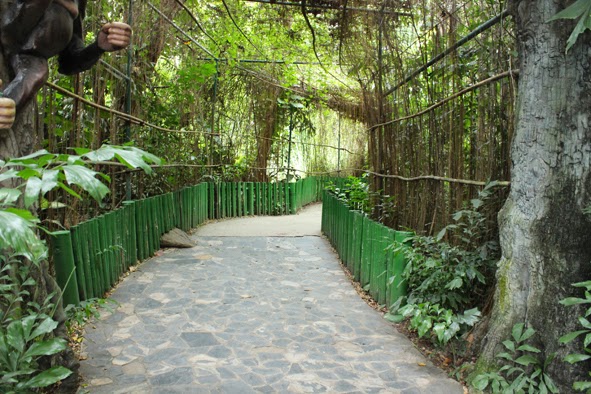On its internet home page, Safari World bills itself as “
Drive through Safari
We started our visit by going
on the drive-through in the safari park which wraps around the outer parts of
the property. According to the brochure, this drive stretches for a 5 kilometer
circuit. I was pleasantly surprised that
we were able to proceed at our own pace.
The vehicle paths in this safari park were wide enough that we could
stop in front of our favorite animals for a longer look and allow other cars to
pass. We first saw Painted storks and
Marabou storks; and then camels, giraffes, zebras, and white rhinos.
The
giraffe area was quite impressive. In Japan
The
next area included animals such as nilgai, gaurs, impalas, blackbucks,
wildebeest, oryx, pelicans, and various types of deer. This area was remarkable for the very large
number of animals, and by the fact that the animals seemed to have eaten all of
the grass that grew here. All of the
ground was starkly bare.
Looking
at the large number of animals, and especially the number of young animals, one
can deduce that breeding efforts at Safari World are very successful. But with larger numbers of animals, I would
think there needs to be larger living spaces.
I had the impression that, for many of the species in the drive-through
section, there were too many individuals crowded into too small a space. The below photo of the ostriches seems to indicate
that something needs to be fixed.
Big Cat Feeding Show
The
drive-through area housing the carnivore lions and tigers was separated from
the areas housing the herbivores by double-gated security entrances. The best thing about this area was that it
comprised a smaller circuit within the larger drive-through circuit. For that reason, after we made one pass
through the lion and tiger areas, we were able to loop around for another
look. Our hired driver knew approximately
when the “Feeding Show” would take place, so he strategically timed our second
loop to coincide with the show. The “Feeding
Show” featured a pick-up truck that had a cage built onto the cargo bed. An attractive young woman stationed inside of
the cage pushed out pieces of raw chicken through slots built into the cage. The lions and tigers appeared to be quite
accustomed to what is surely a daily routine.
As soon as the feeding truck appeared, the big cats all climbed aboard
to their favorite positions.
We
were able to follow the feeding truck from the lion feeding area to the tiger
feeding area. I was amazed that none of
the lions tried to follow the truck into the tiger area. I guess the cats are very well trained as
regards to where they will be fed.
Below
is a video of the tiger feeding:
After
watching the feeding show, we returned to the outer circuit and completed the
drive-through safari. The last animals
were the bears.
Elephant Show
After
completing the drive-through safari, we entered the “regular” part of the
zoo. There were a number of animal performance
shows featuring orangutans, sea lions, elephants, dolphins, and birds. We saw the sea lion show and the elephant
show. Both the sea lions and the
elephants were trained to perform quite extraordinary feats.
These
four elephants painted pictures that were later offered for sale.
Around
the world, there is considerable controversy about the use of animals (especially
elephants) in these types of entertainment activities, with accusations that
training usually includes methods that constitute animal abuse. To be fair,
from the shows that we observed, it wasn’t possible to know whether such
methods were or weren’t used with these animals. But even assuming that gentle
training methods were employed, some of the stunts that the elephants were
required to perform seemed to be quite unnatural and over-the-top. One would think that there must be a way to
allow the animals to demonstrate their unique talents and skills without
forcing them to do strange and demeaning tricks.
Giraffe feeding
At the safari terrace which
overlooked a portion of the drive-through safari, visitors could buy various
fruits to feed to the giraffes. It was
really impressive to see so many giraffes at such close range. Judging from the shrieks of joy and the many
broad smiles, this activity made a considerable impression on the visitors who
experienced it.
Other Animal Exhibits
The zoo portion of Safari
World had many more animals.
Unfortunately, since we spent so much time in the drive-through safari
and watching the two animal shows and stuffing our faces at the lunch buffet,
there wasn’t that much time to carefully observe the other animal
enclosures. The two photos below were
taken while quickly walking past cages housing birds and monkeys.
After
lunch, we watched the “Spy War Show” which seemed quite similar to what you
would expect to see at movie theme parks.
Right in the middle of the spy wars show there was a sudden thunderstorm
that stopped the performance for almost a whole hour. The rain came down so
hard it looked like someone had turned on a giant shower. Luckily, we were under a large roofed area,
and so we managed to remain mostly dry. By the time the storm passed, the
walkways throughout the zoo had been turned into ankle-deep streams, and just
about all of the visitors in the zoo, including us, carefully made their way to
the exit.
Food and Souvenirs
Throughout the zoo, there were
many restaurants, snack stands, and souvenir shops. For us tourist visitors, there was no
shortage of places to spend our money.
Getting There
Safari
World is located in the outskirts of Bangkok Thailand
(Note:
All photos taken in this post were taken during a visit on September 6, 2013. The comments in this post are based on
observations made on that day.
Conditions may have since changed.
Please check it out for yourself!)





































